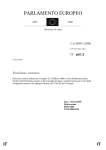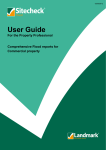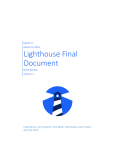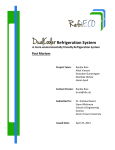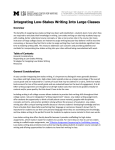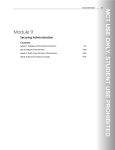Download Appendix A Cumbria County Council MWDF SFRA User Guide
Transcript
Cumbria County Council MWDF STRATEGIC FLOOD RISK ASSESSMENT (SFRA) Appendix A Cumbria County Council MWDF SFRA User Guide October 2007 Cumbria County Council MWDF STRATEGIC FLOOD RISK ASSESSMENT (SFRA) October 2007 October 2007 No No Is proposed land use categorised as ‘less’ vulnerable (PPS25 Table D2)? Yes Is proposed allocation situated within Zone 3a High Probability? Is proposed allocation situated within Zone 3b Functional Floodplain? No PPS25 related constraints upon development No Is proposed allocation situated within Zone 2 Medium Probability? Yes No Yes It must be demonstrated that the development provides wider sustainability benefits to the community that outweigh flood risk. Planning conditions must be in place to ensure that the development will be safe, without increasing the flood risk elsewhere and, where possible, will reduce flood risk overall. Strategic Flood Risk Assessment User Guide (Planning) Yes Is proposed land use categorised as ‘highly vulnerable’ (PPS25 Table D2)? Development must be restricted in accordance with Section 6.4.3 of the SFRA Development must be restricted to ‘water compatible uses’ (PPS25 Table D2) It is necessary for the development to pass The Exception Test Yes No Yes Is proposed allocation an existing developed site? No The development should be on developable previously developed land. If it is not on previously developed land, then there must be no reasonable alternative sites on developable previously developed land. Council Planners must work through The Sequential Test (refer SFRA Section 6.4.1) before considering the nature of the development as outlined below Cumbria County Council MWDF STRATEGIC FLOOD RISK ASSESSMENT (SFRA) October 2007 No PPS25 is satisfied. A drainage impact assessment is required to ensure development does not exacerbate localised flooding problems elsewhere. Within Zone 2 Medium Probability it will be necessary to demonstrate that the residual risk of flooding to the property is effectively managed through, for example, the raising of floor levels and the provision of a planned evacuation route and/or safe haven. Refer SFRA Section 6.3. No Yes It is necessary for the development to pass The Exception Test No No Yes Is proposed land use categorised as ‘highly vulnerable’ (PPS25 Table D2)? Development must be restricted in accordance with Section 6.4.3 of the SFRA Yes Is development situated within Zone 2 Medium Probability? Development must be restricted to ‘water compatible uses’ (PPS25 Table D2) No A detailed FRA must demonstrate that the risk to property and life within the site (due to flooding) can be mitigated over the lifetime of the development, resulting in no worsening to adjoining properties. Where possible, a reduction in flood risk should be sought. Refer SFRA Section 6.3. Strategic Flood Risk Assessment User Guide (Development Control) If not on previously developed land, the developer must demonstrate that there are no reasonable alternative sites on developable previously developed land. The developer must demonstrate that the development provides wider sustainability benefits to the community that outweigh flood risk. PPS25 is satisfied. A detailed FRA must demonstrate the risk to property and life within the site (due to flooding) can be mitigated over the lifetime of the development, resulting in no worsening to adjoining properties. Refer SFRA Section 6.3. Yes Is proposed land use categorised as ‘less’ vulnerable (PPS25 Table D2)? Yes No Is development situated within Zone 3b Functional Floodplain? Is development situated within Zone 3a High Probability? Developers must work through The Sequential Test (refer SFRA Section 6.4.1) before considering the nature of the development as outlined below Cumbria County Council MWDF STRATEGIC FLOOD RISK ASSESSMENT (SFRA) Cumbria County Council MWDF STRATEGIC FLOOD RISK ASSESSMENT (SFRA) Appendix B Cumbria County Council Overview Maps October 2007 Cumbria County Council MWDF STRATEGIC FLOOD RISK ASSESSMENT (SFRA) October 2007 Minerals and Waste Development Framework Strategic Flood Risk Assessment Site: AL3, 5, 18 AL3 AL5 AL18 Key: Potential Minerals and Waste Site Zone 3b Functional Floodplain Zone 3a High Probability Zone 2 Medium Probability Flood Defence Structure Site Information Land Use: PPS25 Vulnerability Classification: Area of Site (ha): Waste Management/Treatment Facilities Less vulnerable AL3: 10.6ha AL5: 2.4ha AL18: 2.9ha Overview of Flood Risks • • • • • The flood risk to these sites is likely to be from a mixture of fluvial and tidal sources (River Derwent & Irish Sea). Detailed modelling suggests that the sites are not located in Zone 3a High Flood Risk from fluvial sources. However, they are still situated on Zone 3a High Probability land from tidal flooding. During a flood event the sites may be surrounded by flood waters on all sides. They may become a ‘dry island’ and be cut off from the surrounding areas. The sites are within the Environment Agency Flood Warning Area - ‘Cumbrian coastline from Silloth to St Bees’. A detailed FRA will be required to demonstrate that the risk of flooding is not made worse by the proposed development. Planning Recommendations • There are no restrictions under PPS25. The proposed land use is ‘less vulnerable’ and is appropriate for Zone 3a High Probability. Potential Development Control Measures • • • • Flood risk to site should be minimised at design stage so that the proposed layout and form does not include any buildings within identified risk areas. Threshold levels should be above predicted 1in 100 year fluvial flood level plus an allowance for climate change, or above the 1 in 200 year tidal flood levels plus sea-level rise allowances. SUDS are required to limit run-off from the site to that of undeveloped land. Flood evacuation procedures and routes should be developed with advice from the emergency services as part of the FRA. Minerals and Waste Development Framework Strategic Flood Risk Assessment Site: AL8 Key: Potential Minerals and Waste Site Zone 3b Functional Floodplain Zone 3a High Probability Zone 2 Medium Probability Flood Defence Structure Site Information Land Use: PPS25 Vulnerability Classification: Size of development: Waste Management/Treatment Facilities Less vulnerable Up to 4.5ha Overview of Flood Risks • • • • The site is located out of the flood risk zone. A small open unnamed drain passes through site, which could cause localised critical drainage problems. The unnamed drain passes into culvert within site which will have maintenance issues and increase flood risk from the watercourse. A detailed FRA will be required to demonstrate that the risk of flooding is not made worse by the proposed development. Planning Recommendations • There are no restrictions under PPS25. Potential Development Control Measures • • • Flood risk to site should be minimised at design stage so that the proposed layout and form does not include any buildings within identified risk areas Threshold levels should be above predicted 1in 100 year flood level plus an allowance for climate change SUDS are required to limit run-off from the site to that of undeveloped land Minerals and Waste Development Framework Strategic Flood Risk Assessment Site: AL19 Key: Potential Minerals and Waste Site Zone 3b Functional Floodplain Zone 3a High Probability Zone 2 Medium Probability Flood Defence Structure Site Information Land Use: PPS25 Vulnerability Classification: Size of Development: Waste Management/Treatment Facilities Less vulnerable 1.5 to 2.0 ha Overview of Flood Risks • • The proposed site is at risk of flooding from both tidal and fluvial sources (Wath Beck) and is located in Zone 3a High Probability according to Environment Agency Flood Zone Maps. A detailed FRA will be required to: i. identify the functional floodplain and ensure that proposed development is not within Zone 3b ii. demonstrate that the risk of flooding is not made worse by the proposed development. Planning Recommendations • There are no current restrictions under PPS25. Potential Development Control Measures • • • Flood risk to site should be minimised at design stage so that the proposed layout and form does not include any buildings within identified risk areas. Threshold levels should be above predicted 1in 100 year flood level plus an allowance for climate change for fluvial flooding or the 1 in 200 year flood level plus allowances for sea-level rise. SUDS are required to limit run-off from the site to that of undeveloped land. Minerals and Waste Development Framework Strategic Flood Risk Assessment Site: AL30 Key: Potential Minerals and Waste Site Zone 3b Functional Floodplain Zone 3a High Probability Zone 3a Zone 2 Plus Medium Probability Climate Change Site Information Land Use: PPS25 Vulnerability Classification: Size of Development: Waste Management/Treatment Facilities Less vulnerable Up to 4.5 ha Overview of Flood Risks • • Black Beck is situated on the southern border of the site. Detailed modelling has shown that the proposed facility is located within Zone 3b Functional Floodplain from the watercourse. Planning Recommendations • • The proposed land use is not appropriate according to PPS25. Alternative sites within areas at lower flood risk should be considered. Potential Development Control Measures • Not appropriate. Site: Minerals and Waste Development Framework Strategic Flood Risk Assessment AL31 AL31 Key: Potential Minerals and Waste Site Zone 3b Functional Floodplain Zone 3a High Probability Zone 2 Medium Probability Flood Defence Structure Site Information Land Use: PPS25 Vulnerability Classification: Size of Development: Waste Management/Treatment Facilities Less vulnerable 1.5 to 2.0 ha Overview of Flood Risks • • • There is a minor area of Zone 3a High Risk on the western border of Risehow Industrial Estate which appears to be related to the backing up fluvial flows during high tides. The two small watercourses that border the site to the north and the south have not been modelled and could pose a localised flood risk. A detailed FRA will be required to demonstrate that the risk of flooding is not made worse by the proposed development. Planning Recommendations • There are no restrictions under PPS25. Potential Development Control Measures • • • Flood risk to site should be minimised at design stage so that the proposed layout and form does not include any buildings within identified risk areas Threshold levels should be above predicted 1in 100 year fluvial flood level plus an allowance for climate change, or above the 1 in 200 year tidal flood levels plus sea-level rise allowances. SUDS are required to limit run-off from the site to that of undeveloped land. Minerals and Waste Development Framework Strategic Flood Risk Assessment Site: BA23 Key: Potential Minerals and Waste Site Zone 3b Functional Floodplain Zone 3a High Probability Zone 2 Medium Probability Flood Defence Structure Site Information Land Use: PPS25 Vulnerability Classification: Size of Development: Waste Management/Treatment Facilities Less vulnerable 1.5 to 2 ha Overview of Flood Risks • • • The site is not identified as being within any existing flooding zones, but according to maps there are several areas of ponded water. Groundwater levels in the potential development area may present flood risks throughout the site A detailed FRA will be required to demonstrate that the risk of flooding is not made worse by the proposed development. Planning Recommendations • There are no current restrictions under PPS25. Potential Development Control Measures • • • Buildings could be constructed on the higher areas of ground. Threshold levels of any buildings constructed on the site should be constructed significantly above ground level. SUDS are required to limit run-off from the site to that of undeveloped land. Minerals and Waste Development Framework Strategic Flood Risk Assessment Site: CA2 Key: Potential Minerals and Waste Site Zone 3b Functional Floodplain Zone 3a High Probability Zone 2 Medium Probability Flood Defence Structure Site Information Land Use: PPS25 Vulnerability Classification: Size of Development: Household Waste and Recycling Centre Less vulnerable 0.6 ha (approx) Overview of Flood Risks • • • The potential site is located next to a small unnamed watercourse. The site is not identified as being within any existing flooding zones, but the watercourse has not been modelled. A detailed FRA will be required to: i. identify the functional floodplain of this watercourse and ensure that proposed development is not within Zone 3b ii. demonstrate that the risk of flooding is not made worse by the proposed development. Planning Recommendations • There are no current restrictions under PPS25. Potential Development Control Measures • • • Flood risk to site should be minimised at design stage so that the proposed layout and form does not include any buildings within identified risk areas Threshold levels should be above predicted 1in 100 year flood level plus an allowance for climate change SUDS are required to limit run-off from the site to that of undeveloped land. Minerals and Waste Development Framework Strategic Flood Risk Assessment Site: CA6 Key: Potential Minerals and Waste Site Zone 3b Functional Floodplain Zone 3a High Probability Zone 2 Medium Probability Flood Defence Structure Site Information Land Use: PPS25 Vulnerability Classification: Size of Development: Waste Management/Treatment Facilities Less vulnerable 1.5 to 2.0 ha Overview of Flood Risks • • • The potential site is not located on any identified areas of significant flood risk according to Environment Agency maps. The site is situated on land that includes a small unnamed watercourse, which may pose a localised flood risk. A detailed FRA will be required to: i. identify the functional floodplain of this watercourse and ensure that proposed development is not within Zone 3b ii. demonstrate that the risk of flooding is not made worse by the proposed development. Planning Recommendations • There are no current restrictions under PPS25, though there is a strong possibility that an FRA will identify flood risks from the unnamed watercourse. The size of the site could be reduced as not to include areas adjacent to the watercourse (Note that the Environment Agency typically request a buffer of 8m either side of the bank to be left free from development). Potential Development Control Measures • • • Flood risk to site should be minimised at design stage so that the proposed layout and form does not include any buildings within identified risk areas. Threshold levels should be above predicted 1in 100 year flood level plus an allowance for climate change. SUDSare required to limit run-off from the site to that of undeveloped land. Minerals and Waste Development Framework Strategic Flood Risk Assessment Site: CA8 Key: Potential Minerals and Waste Site Zone 3b Functional Floodplain Zone 3a High Probability Zone 2 Medium Probability Flood Defence Structure Site Information Land Use: PPS25 Vulnerability Classification: Size of Development: Household Waste and Recycling Centre Less vulnerable 0.6 ha (approx) Overview of Flood Risks • • • The potential site is located adjacent to Brampton Beck and is within flood risk ‘Zone 3a High Probability’. ‘Zone 3b Functional Floodplain’ has not been modelled for this watercourse, but the site is close enough to the channel to have a high chance of being within the natural floodplain. A detailed FRA will be required to: i. identify the functional floodplain of this watercourse and ensure that proposed development is not within Zone 3b ii. demonstrate that the risk of flooding is not made worse by the proposed development. Planning Recommendations • There are no current restrictions under PPS25, but considering the high availability of land in ‘Zone 1 Low Probability’, which is immediately adjacent to the site, other sites should be considered. Potential Development Control Measures • • • Flood risk to site should be minimised at design stage so that the proposed layout and form does not include any buildings within identified risk areas. Threshold levels should be above predicted 1in 100 year flood level plus an allowance for climate change. SUDS are required to limit run-off from the site to that of undeveloped land. Minerals and Waste Development Framework Strategic Flood Risk Assessment Site: CA11 Key: Potential Minerals and Waste Site Zone 3b Functional Floodplain Zone 3a High Probability Zone 2 Medium Probability Flood Defence Structure Site Information Land Use: Waste Management/Treatment Facilities Overview of Flood Risks • • • • • The potential site is located adjacent to the River Eden and a minor tributary, Parham Beck. The site is situated on areas of Zone 3b Functional Floodplain and Zone 3a High Probability flood risk which has been identified through detailed modelling. A Flood Alleviation Scheme, due for completion in 2010, will protect the area to a 1 in 200 year standard (0.5%AEP). A high flood risk will still remain due to flooding from pluvial sources (rainwater). A detailed FRA will be required to: i. demonstrate that the residual risks of flooding will acceptable for the lifetime of the development and can be managed effectively. ii. demonstrate that the risk of flooding elsewhere is not increased, including pluvial flooding, as a result of the proposed development. Planning Recommendations • • There are presently areas of the site which are situated in Zone 3b Functional Floodplain which are not appropriate for the proposed land use according to PPS25. Following the completion of the Flood Alleviation Scheme the proposed site should be suitable for the proposed development, providing pluvial and residual flood risks can be managed. Potential Development Control Measures • • Flood risk to site should be minimised at design stage so that the proposed layout and form does not include any buildings within identified risk areas. SUDS are required to limit run-off from the site to that of undeveloped land. Minerals and Waste Development Framework Strategic Flood Risk Assessment Site: CA13 Key: Potential Minerals and Waste Site Zone 3b Functional Floodplain Zone 3a High Probability Zone 2 Medium Probability Flood Defence Structure Site Information Land Use: PPS25 Vulnerability Classification: Size of Development: Waste Management/Treatment Facilities Less vulnerable Up to 4.5 ha Overview of Flood Risks • • • The site is located on land that is classified as Zone 1 Low Probability. Localised flood risks may be posed by the large number of unnamed drains and watercourses that cross the site A detailed FRA will be required to: i. identify the level of risk posed by the small watercourses ii. ensure that proposed development is not within Zone 3b iii. demonstrate that the risk of flooding is not made worse by the proposed development. Planning Recommendations • There are no current restrictions under PPS25. Potential Development Control Measures • • • Flood risk to site should be minimised at design stage so that the proposed layout and form does not include any buildings within identified risk areas. Threshold levels should be above predicted 1in 100 year flood level plus an allowance for climate change. SUDS are required to limit run-off from the site to that of undeveloped land. Minerals and Waste Development Framework Strategic Flood Risk Assessment Site: CA24 Key: Potential Minerals and Waste Site Zone 3b Functional Floodplain Zone 3a High Probability Zone 2 Medium Probability Flood Defence Structure Site Information Land Use: PPS25 Vulnerability Classification: Size of Development: Waste Management/Treatment Facilities Less vulnerable 1.5 to 2.0 ha Overview of Flood Risks • • • The site is located on land that is classified as Zone 1 Low Probability. Localised flood risks may be posed by the large number of unnamed drains and watercourses that cross the site A detailed FRA will be required to: i. identify the level of risk posed by the small watercourses ii. ensure that proposed development is not within Zone 3b iii. demonstrate that the risk of flooding is not made worse by the proposed development. Planning Recommendations • There are no current restrictions under PPS25. Potential Development Control Measures • • • Flood risk to site should be minimised at design stage so that the proposed layout and form does not include any buildings within identified risk areas. Threshold levels should be above predicted 1in 100 year flood level plus an allowance for climate change. SUDS are required to limit run-off from the site to that of undeveloped land. Minerals and Waste Development Framework Strategic Flood Risk Assessment Site: CA26 CA26 Key: Potential Minerals and Waste Site Zone 3b Functional Floodplain Zone 3a High Probability Zone 2 Medium Probability Flood Defence Structure Site Information Land Use: PPS25 Vulnerability Classification: Size of Development: Waste Management/Treatment Facilities Less vulnerable 1.5 to 2.0 ha Overview of Flood Risks • • • • The potential site is located adjacent to Milton Beck and is within flood risk ‘Zone 3a High Probability’. ‘Zone 3b Functional Floodplain’ has not been modelled for this watercourse, but the site is likely to be within the natural floodplain. The watercourse passes underneath two access roads. These bridges/culverts are susceptible to blockage A detailed FRA will be required to: i. identify the functional floodplain of this watercourse and ensure that proposed development is not within Zone 3b. ii. demonstrate that the risk of flooding is not made worse by the proposed development. Planning Recommendations • There are no current restrictions under PPS25. Though the development of certain parts of the site may be limited following detailed investigations. Potential Development Control Measures • • • Flood risk to site should be minimised at design stage so that the proposed layout and form does not include any buildings within identified risk areas. Threshold levels should be above predicted 1in 100 year flood level plus an allowance for climate change. SUDS are required to limit run-off from the site to that of undeveloped land. Minerals and Waste Development Framework Strategic Flood Risk Assessment Site: CO8 Key: Potential Minerals and Waste Site Zone 3b Functional Floodplain Zone 3a High Probability Zone 2 Medium Probability Flood Defence Structure Site Information Land Use: PPS25 Vulnerability Classification: Size of Development: Household Waste Recycling Centre Less vulnerable 0.6 ha (approx) Overview of Flood Risks • • • Large areas of High Risk – Zone 3a surrounding the site and the flooding is from both coastal and fluvial sources. Western border of site is within High Risk - Flood Zone 3a Potential for employees and users of the site to become isolated during a flood event Planning Recommendations • There are no restrictions under PPS25. Potential Development Control Measures • • • Threshold levels should be above predicted 1in 100 year flood level plus an allowance for climate change. SUDS are required to limit run-off from the site to that of undeveloped land. The site should be subject to a specific flood warning and safety plan. Minerals and Waste Development Framework Strategic Flood Risk Assessment Site: CO11 Key: Potential Minerals and Waste Site Zone 3b Functional Floodplain Zone 3a High Probability Zone 2 Medium Probability Flood Defence Structure Site Information Land Use: PPS25 Vulnerability Classification: Size of Development: Waste Management/Treatment Facilities Less vulnerable 1.5 to 2.0 ha Overview of Flood Risks • • • • The site is located out of the flood risk zone. A small open unnamed drain passes through site, which could cause localised critical drainage problems. The unnamed drain passes into culvert within site which will have maintenance issues and increase flood risk from the watercourse . A detailed FRA will be required to demonstrate that the risk of flooding is not made worse by the proposed development. Planning Recommendations • There are no restrictions under PPS25. Potential Development Control Measures • • • Flood risk to site should be minimised at design stage so that the proposed layout and form does not include any buildings within identified risk areas. Threshold levels should be above predicted 1in 100 year flood level plus an allowance for climate change. SUDS are required to limit run-off from the site to that of undeveloped land. Minerals and Waste Development Framework Strategic Flood Risk Assessment Site: CO13 Key: Potential Minerals and Waste Site Zone 3b Functional Floodplain Zone 3a High Probability Zone 2 Medium Probability Flood Defence Structure Site Information Land Use: PPS25 Vulnerability Classification: Size of Development: Household Waste Recycling Centre Less vulnerable 1.5 to 2.0 ha Overview of Flood Risks • • • Significant proportion of site is within High Risk Flood Zone 3a There are structures providing a flood defence function partially protecting the site. A residual risk of flooding due to overtopping and/or collapse. A detailed FRA will be required to demonstrate that the risk of flooding is not made worse by the proposed development. Planning Recommendations • • There are no restrictions under PPS25 LA should consider if other areas of land with a lower level flood risk are available, preferably Low Flood Risk Zone 1. Potential Development Control Measures • • • Threshold levels for all buildings should be above predicted 1in 100 year flood level plus an allowance for climate change. SUDS are required to limit run-off from the site to that of undeveloped land. The proposed development should not adversely alter existing flood regime. Flood levels outside of the site must not be increased as a result of the proposed development. Minerals and Waste Development Framework Strategic Flood Risk Assessment Site: M5 Key: Potential Minerals and Waste Site Zone 3b Functional Floodplain Zone 3a High Probability Zone 2 Medium Probability Flood Defence Structure Site Information Land Use: PPS25 Vulnerability Classification: Area of Site (Ha): Mineral Extraction (clay) Less vulnerable NA Overview of Flood Risks • • The site is located on land that is classified as Zone 1 Low Probability. Localised flood risks may be posed by the unnamed drains and watercourses that cross the site. Planning Recommendations • There are no restrictions under PPS25. Potential Development Control Measures • The impacts of mineral extraction activities on the water environment vary from site to site and depending upon the method of extraction. Initially all potential impacts should be considered. Minerals and Waste Development Framework Strategic Flood Risk Assessment Site: M8 Key: Potential Minerals and Waste Site Zone 3b Functional Floodplain Zone 3a High Probability Zone 2 Medium Probability Flood Defence Structure Site Information Land Use: PPS25 Vulnerability Classification: Area of Site (Ha): Mineral Extraction (sand & gravel) Water Compatible NA Overview of Flood Risks • • • The site is located on land that is classified as Zone 3a High Probability. The headwaters of the River Wampool and several unnamed drains and watercourses cross the site. A detailed FRA will be required to demonstrate that the risk of flooding is not made worse by the proposed development. Planning Recommendations • There are no restrictions under PPS25. Potential Development Control Measures • The impacts of mineral extraction activities on the water environment vary from site to site and depending upon the method of extraction. Initially all potential impacts should be considered. Minerals and Waste Development Framework Strategic Flood Risk Assessment Site: M11 Key: Potential Minerals and Waste Site Zone 3b Functional Floodplain Zone 3a High Probability Zone 2 Medium Probability Flood Defence Structure Site Information Land Use: PPS25 Vulnerability Classification: Area of Site (Ha): Mineral Extraction (sand & gravel) Water Compatible NA Overview of Flood Risks • • • The site is located on land that is classified as Zone 3a High Probability. The headwaters of the Milton Beck and unnamed drains cross the site. A detailed FRA will be required to demonstrate that the risk of flooding (downstream) is not made worse by the proposed development Planning Recommendations • There are no restrictions under PPS25. Potential Development Control Measures • The impacts of mineral extraction activities on the water environment vary from site to site and depending upon the method of extraction. Initially all potential impacts should be considered. Minerals and Waste Development Framework Strategic Flood Risk Assessment Site: M18 Key: Potential Minerals and Waste Site Zone 3b Functional Floodplain Zone 3a High Probability Zone 2 Medium Probability Flood Defence Structure Site Information Land Use: PPS25 Vulnerability Classification: Area of Site (Ha): Mineral Extraction (gypsum) Less Vulnerable NA Overview of Flood Risks • • The site is mostly located on land that is classified as Zone 1 Low Probability. There is a narrow band of Zone 3a High Probability associated with Keld Sike, which crosses the proposed site. Planning Recommendations • There are no restrictions under PPS25. Potential Development Control Measures • The impacts of mineral extraction activities on the water environment vary from site to site and depending upon the method of extraction. Initially all potential impacts should be considered. Minerals and Waste Development Framework Strategic Flood Risk Assessment Site: SL11 Key: Potential Minerals and Waste Site Zone 3b Functional Floodplain Zone 3a High Probability Zone 2 Medium Probability Flood Defence Structure Site Information Land Use: PPS25 Vulnerability Classification: Size of Development: Household waste recycling centre Less vulnerable 1.5 to 2.0 ha Overview of Flood Risks • • • • • Significant proportion of site is within High Risk Flood Zone 3a. Flooding is from fluvial and coastal sources. Dragley Beck is a known flooding problem to north. Several small watercourses in vicinity increase the likelihood of critical drainage issues. Potential for employees and users of the site to become isolated during a flood event. Planning Recommendations • There are no restrictions under PPS25. Potential Development Control Measures • • • Threshold levels should be above predicted 1in 100 year flood level plus an allowance for climate change. SUDS are required to limit run-off to that of undeveloped and natural land. Site should be subject to a specific flood warning and evacuation plan, developed at FRA stage and in consultation with emergency services. Cumbria County Council MWDF STRATEGIC FLOOD RISK ASSESSMENT (SFRA) October 2007 Cumbria County Council MWDF STRATEGIC FLOOD RISK ASSESSMENT (SFRA) Appendix C Tables D1, D2 & D3 from PPS 25 October 2007 Cumbria County Council MWDF STRATEGIC FLOOD RISK ASSESSMENT (SFRA) October 2007 Cumbria County Council MWDF STRATEGIC FLOOD RISK ASSESSMENT (SFRA) Table D.1: Flood Zones (Note: These Flood Zones refer to the probability of river and sea flooding, ignoring the presence of defences) Zone 1 Low Probability Definition This zone comprises land assessed as having a less than 1 in 1000 annual probability of river or sea flooding in any year (<0.1%). Appropriate uses All uses of land are appropriate in this zone. FRA requirements For development proposals on sites comprising one hectare or above the vulnerability to flooding from other sources as well as from river and sea flooding, and the potential to increase flood risk elsewhere through the addition of hard surfaces and the effect of the new development on surface water run-off, should be incorporated in a FRA. This need only be brief unless the factors above or other local considerations require particular attention. See Annex E for minimum requirements. Policy aims In this zone, developers and local authorities should seek opportunities to reduce the overall level of flood risk in the area and beyond through the layout and form of the development, and the appropriate application of sustainable drainage techniques. Zone 2 Medium Probability Definition This zone comprises land assessed as having between a 1 in 100 and 1 in 1000 annual probability of river flooding (1% – 0.1%) or between a 1 in 200 and 1 in 1000 annual probability of sea flooding (0.5% – 0.1%) in any year. Appropriate uses The water-compatible, less vulnerable and more vulnerable uses of land and essential infrastructure in Table D.2 are appropriate in this zone. Subject to the Sequential Test being applied, the highly vulnerable uses in Table D.2 are only appropriate in this zone if the Exception Test is passed. FRA requirements All development proposals in this zone should be accompanied by a FRA. See Annex E for minimum requirements. Policy aims In this zone, developers and local authorities should seek opportunities to reduce the overall level of flood risk in the area through the layout and form of the development, and the appropriate application of sustainable drainage techniques. October 2007 Cumbria County Council MWDF STRATEGIC FLOOD RISK ASSESSMENT (SFRA) Zone 3a High Probability Definition This zone comprises land assessed as having a 1 in 100 or greater annual probability of river flooding (>1%) or a 1 in 200 or greater annual probability of flooding from the sea (>0.5%) in any year. Appropriate uses The water-compatible and less vulnerable uses of land in Table D.2 are appropriate in this zone. The highly vulnerable uses in Table D.2 should not be permitted in this zone. The more vulnerable and essential infrastructure uses in Table D.2 should only be permitted in this zone if the Exception Test (see para. D.9) is passed. Essential infrastructure permitted in this zone should be designed and constructed to remain operational and safe for users in times of flood. FRA requirements All development proposals in this zone should be accompanied by a FRA. See Annex E for minimum requirements. Policy aims In this zone, developers and local authorities should seek opportunities to: i. reduce the overall level of flood risk in the area through the layout and form of the development and the appropriate application of sustainable drainage techniques; ii. relocate existing development to land in zones with a lower probability of flooding; & iii. create space for flooding to occur by restoring functional floodplain and flood flow pathways and by identifying, allocating and safeguarding open space for flood storage. Zone 3b The Functional Floodplain Definition This zone comprises land where water has to flow or be stored in times of flood. SFRAs should identify this Flood Zone (land which would flood with an annual probability of 1 in 20 (5%) or greater in any year or is designed to flood in an extreme (0.1%) flood, or at another probability to be agreed between the LPA and the Environment Agency, including water conveyance routes). Appropriate uses Only the water-compatible uses and the essential infrastructure listed in Table D.2 that has to be there should be permitted in this zone. It should be designed and constructed to: – remain operational and safe for users in times of flood; – result in no net loss of floodplain storage; – not impede water flows; and – not increase flood risk elsewhere. Essential infrastructure in this zone should pass the Exception Test. FRA requirements All development proposals in this zone should be accompanied by a FRA. Policy aims In this zone, developers and local authorities should seek opportunities to: i. reduce the overall level of flood risk in the area through the layout and form of the development and the appropriate application of sustainable drainage techniques; and ii. relocate existing development to land with a lower probability of flooding. October 2007 Cumbria County Council MWDF STRATEGIC FLOOD RISK ASSESSMENT (SFRA) Table D.2: Flood Risk Vulnerability Classification Essential Infrastructure • Essential transport infrastructure (including mass evacuation routes) which has to cross the area at risk, and strategic utility infrastructure, including electricity generating power stations and grid and primary substations. Highly Vulnerable • • • • • • Police stations, Ambulance stations and Fire stations and Command Centres and telecommunications installations required to be operational during flooding. Emergency dispersal points. Basement dwellings. Caravans, mobile homes and park homes intended for permanent residential use. Installations requiring hazardous substances consent. More Vulnerable • • • • • • Hospitals. Residential institutions such as residential care homes, children’s homes, social services homes, prisons and hostels. Buildings used for: dwelling houses; student halls of residence; drinking establishments; nightclubs; and hotels. Non–residential uses for health services, nurseries and educational establishments. Landfill and sites used for waste management facilities for hazardous waste. Sites used for holiday or short-let caravans and camping, subject to a specific warning and evacuation plan. Less Vulnerable • • • • • • Buildings used for: shops; financial, professional and other services; restaurants and cafes; hot food takeaways; offices; general industry; storage and distribution; non– residential institutions not included in ‘more vulnerable’; and assembly and leisure. Land and buildings used for agriculture and forestry. Waste treatment (except landfill and hazardous waste facilities). Minerals working and processing (except for sand and gravel working). Water treatment plants. Sewage treatment plants (if adequate pollution control measures are in place). Water-compatible Development • • • • • • • • • • • • Flood control infrastructure. Water transmission infrastructure and pumping stations. Sewage transmission infrastructure and pumping stations. Sand and gravel workings. Docks, marinas and wharves. Navigation facilities. MOD defence installations. Ship building, repairing and dismantling, dockside fish processing and refrigeration and compatible activities requiring a waterside location. Water-based recreation (excluding sleeping accommodation). Lifeguard and coastguard stations. Amenity open space, nature conservation and biodiversity, outdoor sports and recreation and essential facilities such as changing rooms. Essential ancillary sleeping or residential accommodation for staff required by uses in this category, subject to a specific warning and evacuation plan. October 2007 Cumbria County Council MWDF STRATEGIC FLOOD RISK ASSESSMENT (SFRA) Table D.3: Flood Risk Vulnerability and Flood Zone ‘Compatibility’ October 2007 Cumbria County Council MWDF STRATEGIC FLOOD RISK ASSESSMENT (SFRA) Appendix D SFRA Review Procedure October 2007 Cumbria County Council MWDF STRATEGIC FLOOD RISK ASSESSMENT (SFRA) October 2007 Cumbria County Council MWDF STRATEGIC FLOOD RISK ASSESSMENT (SFRA) The SFRA has been developed building heavily upon existing knowledge with respect to flood risk within the district. A rolling programme of detailed flood risk mapping within Cumbria is underway. This, in addition to observed flooding that may occur throughout a year, will improve the current knowledge of flood risk within the district and may marginally alter predicted flood extents. Furthermore, Communities and Local Government (CLG) are working to provide further detailed advice with respect to the application of PPS25, and future amendments to the PPS25 Practice Guide are anticipated. Given that this is the case, a periodic review of the SFRA is imperative. It is recommended that the SFRA is reviewed on a regular basis. The following key questions should be addressed as part of the SFRA review process: Question 1 Has any flooding been observed within the county since the previous review? If so, the following information should be captured as an addendum to the SFRA: ¾ ¾ ¾ ¾ ¾ What was the mapped extent of the flooding? On what date did the flooding occur? What was the perceived cause of the flooding? If possible, what was the indicative statistical probability of the observed flooding event? (i.e. how often, on average, would an event of that magnitude be observed within the county?) If the flooding was caused by overtopping of the riverbanks, are the observed flood extents situated outside of the current Zone 3a? If it is estimated that the frequency of flooding does not exceed, on average, once in every 100 years then the flooded areas (from the river) should be incorporated into Zone 3a to inform future planning decision making. Question 2 Have any amendments to PPS25 or the Practice Companion Guide been released since the previous review? If so, the following key questions should be tested: ¾ Does the revision to the policy guidance alter the definition of the PPS25 Flood Zones presented within the SFRA? (refer Section 5.2) ¾ Does the revision to the policy guidance alter the decision making process required to satisfy the Sequential Test? (refer Section 6.4.1) ¾ Does the revision to the policy guidance alter the application of the Exception Test? (refer Section 6.4.1) ¾ Does the revision to the policy guidance alter the categorisation of land use vulnerability, presented within Table D2 of PPS25 (December 2006)? If the answer to any of these core questions is ‘yes’ then a review of the SFRA recommendations in light of the identified policy change should be carried out. Question 3 Has the Environment Agency issued any amendments to their flood risk mapping and/or standing guidance since the previous policy review? If so: ¾ ¾ ¾ Has any further detailed flood risk mapping been completed within the District, resulting in a change to the 20 year, 100 year or 1000 year flood outline? If yes, then the Zone 3b and Zone 3a flood outlines should be updated accordingly. Has the assessment of the impacts that climate change may have upon rainfall and/or river flows over time altered? (refer Section 5.6) If yes, then a review of the impacts that climate change may have upon the District is required. Do the development control recommendations provided in Section 6.4 of the SFRA in any way contradict emerging EA advice with respect to (for example) the provision of emergency access, the setting of floor levels and the integration of sustainable drainage techniques? If yes, then a discussion with the EA is required to ensure an agreed suite of development control requirements are in place. It is highlighted that the Environment Agency review the Flood Zone Map on a quarterly basis. If this has been revised within the county, the updated Flood Zones will be automatically October 2007 Cumbria County Council MWDF STRATEGIC FLOOD RISK ASSESSMENT (SFRA) forwarded to the Council for their reference. It is recommended that only those areas that have been amended by the Environment Agency since the previous SFRA review are reflected in Zone 3 and Zone 2 of the SFRA flood maps. This ensures that the more rigorous analyses carried out as part of the SFRA process are not inadvertently lost by a simple global replacement of the SFRA flood maps with the Flood Zone Maps. October 2007







































